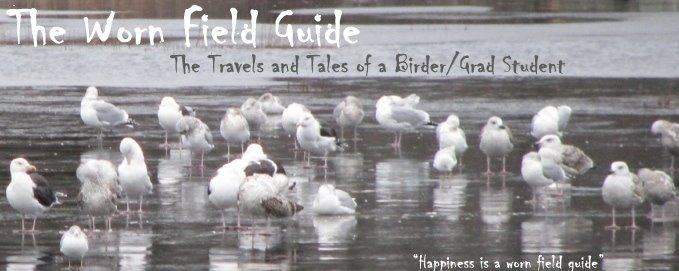5. Do NOT harass birds
Birders harass birds way more than necessary. There is a definite line and you have to know when you're crossing it. Playing tape for nesting birds is a no-no, getting too close for photography another no-no. You may think - what's the big deal if it's only one person. And it may not be a big deal if its only one person. But when it comes to rarities there's no way its only one person.
My students often ask to be an exception to the rule. To get credit for an assignment they didn't do, or for another chance. But rules are rules for a reason. Following the birding ethics is important (http://www.aba.org/about/ethics.html)

Ivory Gull crowd grows in Gloucester, MA
4. Do NOT bird only in the spring-fall
Honestly, the winter can provide some of the most amazing birding. It is a trying experience but wonderful things can be seen. I historically only ever birded when it was nice enough to enjoy being outside. But they make down and gore-tex for good reasons. Use them. Go north! Go see winter finches, Hawk-owls, and Great Grey Owls. Go see Bohemian Waxwings. Spend a day scanning for alcids freezing your bum off! Go look for ducks in the rain. You'll be surprised at how much fun it can be with the right attitude. Besides - its way better than sitting inside getting a cold from being so close to so many people.
3. Do NOT trust people's identifications
Ok that sounds a bit harsh - but seriously - people get things wrong (see number 2). So don't believe everything everyone tells you. Check people's ID's. It is good practice and it helps you learn better details.
2. Do NOT feel bad when you goof up
Everyone does it. You will too. So get over it now. Heck I've even thought sticks were birds before and I've been part of the silliest "Dovekie" experience in NH - where 5+ birders stood around calling a bird a Dovekie even though each and every one of them was thinking "gee it has a really long bill" or "gee thats really bigger than I thought a Dovekie would be'. One listserv post of a photo later the bird was re-identified as a Thick-billed Murre
Day One as a birder I called a Titmouse (pronounced tit - mouse) a Tit-Moose. Yes, its true. Go ahead and laugh. It's no wonder it took me so long to come around from non-birder to birder side of the world.
The point here is - you're going to mess up. But shake it off, move on and learn from your mistake. KNOW WHY you goofed up - and next time work on getting it right. You'll feel really good about it (just as all the Dovekie birders felt really good about properly identifying Thick-billed Murre's on their next pelagic trip).
1. Do NOT be stubborn
Nothing annoys other birders more than when you identify something wrong and refuse to listen to what other say, particularly when you asked for opinions. This happens more than you think. But for that matter, always be willing to listen to what others say. Do not feel bad when you make a mistake. Everyone does it (see #2 again). The important thing is to be open to othe people's comments. If all the evidence is going against you change your identification, or at the very least leave it at the species level.
For example: If you think you've found a Thayer's Gull and everyone says its Herring Gull but you're confident it's not a normal Herring Gull leave it at Larus sp.
If your bird isn't accepted, don't mope about - just go out and find another.
Finally, always remember what the great Steve Mirick said and "do not talk while listening for Winter Wren". At least not at the NH Coastal CBC.








